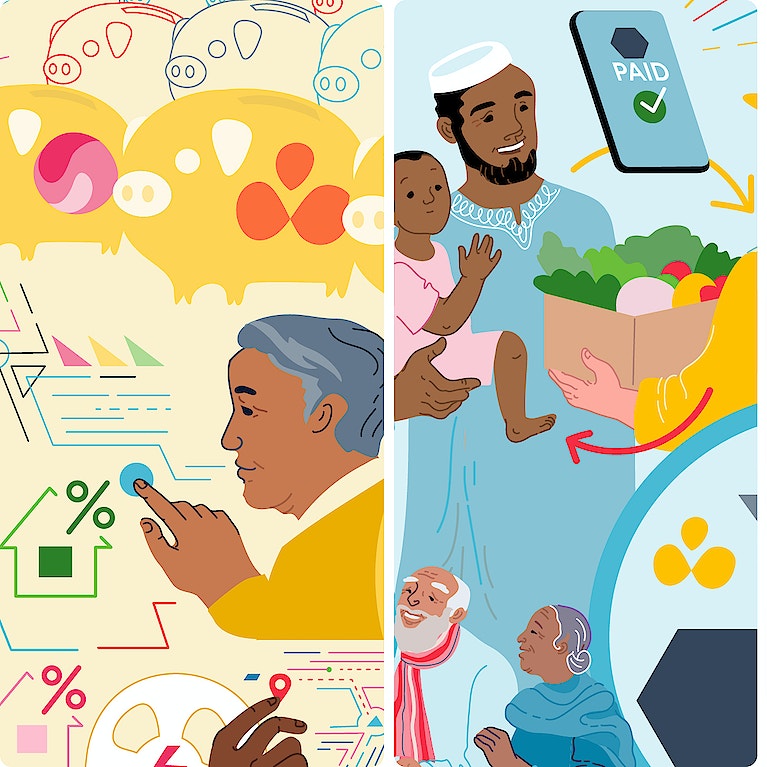
It’s all about the data
An interview with Stefan Stignäs, Head of Exploratory Banking and Strategic Partnerships at SEB
The leading northern European financial services group, SEB, is doubling down on data as a driver for future banking products. In 2021, SEB announced a partnership with Roaring.io, a platform that provides corporate data. In 2022, it partnered with Insurely, a provider of open insurance solutions. We sat down with Stefan Stignäs, Head of Exploratory Banking and Strategic Partnerships at SEB, to find out how he sees the future of banking, insurance, and partnerships.
What is your role at SEB?
Last year, SEB decided to create a business unit that’s solely focused on the next service and product value proposition. We think that in 10 years’ time, 30 to 40 percent of revenue will be generated by products or services that haven’t been invented yet. We have to look that far ahead to stay relevant. Together, with strategic partners, we explore the kind of banking services we should have in the future.
How do you work within exploratory banking?
We work with business cases, but we do so from a pilot or POC (proof of concept) perspective. And it’s all about the client’s data and trying to make it seamless for the customers to share it. With the data as the ‘raw material’, we try to cocreate with strategic partners enhanced or new value propositions for our customers. When customers are willing to share their data from various connected platforms it can be used to create relevant, tailored new services. We believe in a bank-led platform based on data.
Of course, these tailored new services will be based on our core products like payment financing, savings, and insurance. But they will be embedded, consumed, and accessed in new ways. These services might also be priced in a new way, subscription or as a service usage is in demand in today’s more circular economy. We look ahead, we explore, we team up. And once things are rolling, we put them into production.
Do you look for international partners, or are you focused on the Swedish and Nordic market?
My role is within the retail and business banking segment where our target clients are private individuals and small to medium enterprises. We look for clients who can enhance our value proposition and where we can build together with them. The partner could be global, but the market will be Swedish and Nordic. We’re not seeking to expand our business partners outside of that geography.
What do you see happening in the insurance space?
In the insurance market, exactly as it was in the payment market, what can be digitised will be. And where your margins are too big, they’ll be pressured. When you gain more data, you can predict, tailor, and automate better. We also know that convenience trumps cost. So, if you can offer a convenient customer journey, clients are willing to pay a small premium. The driver is to simplify and make it easier for the client. In Sweden, occupational pension is a big part of insurance, and it’s becoming deregulated as we speak. Customers will be able to better choose where they put their savings, something that’s usually combined with life insurance. This creates an opening for new solutions. Open insurance will piggy-back on the thinking behind PSD2, like standardised APIs, where we can use previous experiences to automate and digitise valuable propositions for clients.
My strong belief is that for corporate customers, the main platform is the ERP system. So we’re embedding a lot of seamless financing into ERP systems. For private individuals, it’s the app. We have more than 30 million logins monthly. When I ask individuals if they’ve used their bank today, the answer is always yes, they’ve used my banking app. They look at their equities, payments, or salary. And if I ask, whether they’ve visited an insurance app or website, nobody has for the last month. So, there is an opportunity to build insurance into the banking app. That’s not always what insurance companies want to hear, in the same way banks didn’t want to hear about open banking and FinTech eight years ago. But I think partnerships are the secret sauce. And the platform will be the banking app.
Some InsurTechs are experimenting with ‘just-in-time’ insurance that you can switch on or off. Do you think this will drive change in insurance products?
Yes, I think so. You can already see the trend. Traditionally, for home insurance, you have an annual due date where you can change your coverage. But now, new insurance products don’t always have that kind of lock-in. You can sign on and sign off the next month if you want to. This means you’ll need to stay relevant in your offerings, because the consumer will be able to switch easily and benchmark costs. The way to overcome margin pressure, is to offer a convenient and easy-to-use solution that people will pay for. SEB’s aim is to make the bank portal or the app the centre of gravity, where you manage your insurance using your bank app. Our ambition is to capitalise on traffic, where others are willing to pay for it. We’ve historically seen FinTech and RegTechs define a pain point then they come up with a solution for the pain point that is smart and easy to use. The challenge is that the solution is often niche. To survive, they have learnt to team up with a partner with links into the ecosystem.
So, for FinTech and InsurTech, you’ve got the app functionality. But there are also infrastructure or aggregators out there. Will the market of infrastructure and aggregator suppliers grow?
The value is in the data. I’ve seen a trend where large players want to keep hold of their own raw data. Tier 2 and 3 banks are happy to buy data as a service. So, there are two different value propositions. The big banks that are buying ‘the ingredients’ if you will. And the Tier 2 and 3 banks, are buying ‘readymade dishes’ as a service. The same is happening in InsurTech. I’ll give you one example. If you look at Insurely, it has built APIs to connect with all insurance companies. When SEB has connected our data to the infrastructure, we can mine the data and combine it. The more that infrastructure railroads can be connected, the better it is for the customer.
But the information battle is with hubs that want to collect data to sell. Customers tend to trust banks when it comes to handling their data. You know, they might not like banks. They might think banks are greedy, however they still trust the banks will handle the data correctly. They are unlikely to believe that Facebook or Google will handle their data with such care. So, banks have an opportunity to stay relevant through delivering trust.
What do you see happening in the regulatory space?
Europe is at the forefront of trying to protect the integrity of the consumer. But globally, you need different versions of a product for various geographies, which can be challenging to scale. In Sweden and the Nordics, I think we’ll continue to see consumer-related regulations. I also think there will be de-regulation to encourage competition, as we see now in occupational pensions. You should not be able to lock-in the client, rather, the client should be able to switch easily. For example, today in Sweden, when you prepay your mortgage, a bank can charge a prepayment fee if you exit early. There are ongoing discussions about whether that is fair. So, I think, data will be protected, but the freedom of the customer will become more deregulated here in Europe.
How is SEB tackling changes in legislation and customer behaviour?
We take pride in trying to stay at the forefront of development. We’re an early adopter of technology, so we’ll continue to put resources on exploratory journeys to secure our future relevance. We’ve been in business for 166 years, so we take a long-term perspective. We don’t chase opportunistic things. That is not our business. We want to be transparent. If we partner, you know it is SEB with this party and that if you take us jointly, you can get a better price or quality. We want to be clear on what our brand provides, which is good ethics, high quality, and long-term commitment.
And are you able to share any new propositions that you’re launching in the exploratory space?
We are currently working on ‘SEB NEO’. It’s the first SEB-branded value proposition built in our innovation studio SEBx technology. It’s a family app targeted at children enabling them to learn about money. Many banks have a similar offering, but our idea puts the children in control whilst giving parents an overview of their learning using communication tools. Our ambition is to further develop this with an offering for young entrepreneurs.
How does data influence partnership strategies?
We have many types of partners at SEB. At an exploratory level, we look for partners with whom we can create better solutions for our mutual customers. It could also be to speed up development and time-to-market for new products and services. We co-create together. And it is all about data. So, we take the data, assuming our customer gives us permission, and build something valuable for them. That’s the principle for our strategic partnerships.
When it comes to investment, if our partner is considerably smaller than us, which is the case with many FinTechs, and we could become dependent on them, then we always invest. There are three reasons for this. Firstly, we think we have some experience at SEB in helping to scale businesses. Secondly, if we’re going to co-create, and we think it will increase the value of our partner, we want to be a part of that. Lastly, we want to avoid the possibility of someone unsuitable taking control of our partner companies. We never hold a majority stake, but we usually ask for a board seat. We view it as a partnership with other investors. We also enter strategic partnerships without having a stake in them, but then it’s usually with a larger partner on equal terms.
Do you have any advice for banks or for tech companies about how to work together?
When we’ve been most successful, we have put together joint development teams and enabled them to co-create daily. The only prerequisite is to understand the difference in how a bank develops in comparison to the FinTech or InsurTech. There are different ways of working because of size and regulatory variables. So, when that’s understood and there’s a common roadmap, we have created the most value and people have been happiest. It’s like a first date, everything seems to be possible, but you need to make sure the ground rules are understood. Otherwise, you can easily reach a point where the smaller partner feels that the bank is stiff and cumbersome, or the bank thinks the smaller partner is not serious. Co-creation teams are key, as is defining a roadmap with check points together.
Do you have any last words?
Banks can be slow, but they’re getting up to speed. Today, more and more players believe in the creation of ecosystems. The field is much more defined. Now it’s more about understanding what kind of role you want to play on the team or in the ecosystem. I think we’re just at the beginning of this evolution.
Explore more










